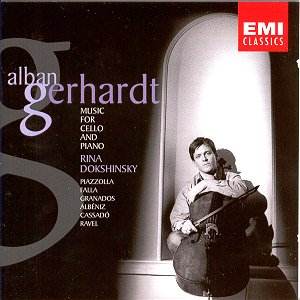MUSIC FOR CELLO AND PIANO
Astor PIAZZOLLA (1921-92)
Le Grand Tango.
Manuel de FALLA
(1876-1946) La vida breve – Danse
espagnole No. 1 (arr. Kreisler/Marechal). El amor brujo – Pantomima
e Cancion (arr. C Schiff); Danse rituelle du feu (arr. Piatigorsky).
Enrique GRANADOS
(1867-1916) Danzas españolas
No. 5 – Andaluza. Tonadilla No. 1 (arr. Fournier). Goyescas – Intermezzo
(arr. Cassadó).
Isaac ALBENIZ
(1860-1909) Celebre Serenata Espagnola
(arr. Cassadó). Malagueña. Tango, Op. 165 No. 2 (arr.
Marechal).
Gaspar CASSADÓ
(1897-1966) Sérénade.
Danse du Diable vert. La Pendule, la fileuse et le galant. Lamento de
Boabdil. Requiebros.
Maurice RAVEL
(1875-1937) Habanera (arr. Bazelaire).
Alborada del grazioso (arr. Castelnuovo-Tedesco).
 Alban Gerhardt (cello);
Rina Dokshinsky (piano).
Alban Gerhardt (cello);
Rina Dokshinsky (piano).
Recorded in Holy Trinity Church, Weston, Hertfordshire in February 1998.
[DDD]
 EMI Debut CDZ5 73164-2
[72'41]
EMI Debut CDZ5 73164-2
[72'41]
Crotchet
AmazonUK
AmazonUS Amazon
recommendations

New York based cellist Alban Gerhardt has already appeared
with many leading orchestras and conductors. By his own admission, he
cannot explain his affection for music of a Mediterranean bent: he is
German with Czech heritage. That he shows a clear affinity for this
music is beyond doubt, however. What makes him different from the usual
Wunderkind is not his phenomenal technique, but rather the fact
that he uses this technique musically at all times. He makes the listener
forget the difficulties of his programme and thus facilitates concentration
on the music itself.
Gerhardt has a warm, glowing sound eminently suitable
to his chosen repertoire. He brings off Piazzolla's Le Grand Tango
by being expressive without overdoing it. The ability to capture the
spirit of melancholic longing which pervades the disc is his great strength.
He is suave and swaying in the first Amor brujo excerpt while
in the Piatigorsky arrangement of Falla's famous Ritual Fire Dance
his excellent pianist really comes in to her own. It is significant
that this piece is programmed towards the middle of the recital, pointing
to the duo's refusal to treat this piece as mere encore material. Dokshinsky
(herself something of a Wunderkind) makes the opening positively
buzz.
Granados gives an opportunity for Gerhardt to show
that he is capable of delicacy, too: Andaluza is eloquent testament
to this, as is Tonadilla No. 1, in which Dokshinsky's perfectly
shaped staccato accompaniments provide the ideal foil for Gerhardt's
lyricism. The duo manage to elevate some of the most famous encores
by lavishing them with tremendous attention to detail. Rhythmic pointing
and placing is exemplary throughout. Just listen to Gaspar Cassadó's
Danse du Diable vert for an example of infectious rhythms, or
to Albéniz's Celebre Serenata Espagnola for sheer playfulness.
This is an intelligently planned recital which is triumphantly
delivered by this duo. Gerhardt is a real find.
Colin Clarke

